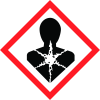3M Urethane Adhesive DP-609 (Part A)
3m company
Revision date : 2021-12-15


Note: Ingredients listed on restricted chemical lists
EC/CAS
5873-54-1
Name of the chemical
2,4’-Methylenediphenyl diisocyanate
Concentration
N/A
EC/CAS
101-68-8
Name of the chemical
4,4’-Methylenediphenyl diisocyanate
Concentration
N/A
EC/CAS
227-534-9
Name of the chemical
2,4’-Methylenediphenyl diisocyanate
Concentration
N/A
EC/CAS
202-966-0
Name of the chemical
4,4’-Methylenediphenyl diisocyanate
Concentration
N/A
General Information
Revision date
2021-12-15
Product name
3M Urethane Adhesive DP-609 (Part A)
Emergency telephone
+44 (0)1344 858 000
Icons in SDS
Company Information
Company name
3m company
E-mail address of the competent person responsible for the Safety Data Sheet
tox.uk@mmm.com
GHS Information
Signal word
Danger
Hazard Codes
Hazard statements (CLP)
H315, H317, H319, H332, H334, H335, H351, H373
Hazard statements
Code
Statements
H315
Causes skin irritation
H317
May cause an allergic skin reaction
H319
Causes serious eye irritation
H332
Harmful if inhaled
H334
May cause allergy or asthma symptoms or breathing difficulties if inhaled
H335
May cause respiratory irritation
H351
Suspected of causing cancer
H373
May causes damage to organs through prolonged or repeated exposure
Precautionary statements
Code
Statements
P280
Wear protective gloves/protective clothing/eye protection/face protection.
P304+P340
IF INHALED: Remove person to fresh air and keep comfortable for breathing.
P305+P351+P338
IF IN EYES: Rinse cautiously with water for several minutes. Remove contact lenses if present and easy to do - continue rinsing.
P333+P313
IF SKIN irritation or rash occurs: Get medical advice/attention.
P342+P311
IF experiencing respiratory symptoms: Call a POISON CENTER/doctor/...
Section 2
2.1 Classification of the substance or mixture
CLP REGULATION (EC) No 1272/2008 The health and environmental classifications of this material have been derived using the calculation method, except in cases where test data are available or the physical form impacts classification. Classification(s) based on test data or physical form are noted below, if applicable. Acute Toxicity, Category 4 - Acute Tox. 4; H332 Skin Corrosion/Irritation, Category 2 - Skin Irrit. 2; H315 Serious Eye Damage/Eye Irritation, Category 2 - Eye Irrit. 2; H319 Respiratory Sensitization, Category 1 - Resp. Sens. 1; H334 Skin Sensitization, Category 1 - Skin Sens. 1; H317 Carcinogenicity, Category 2 - Carc. 2; H351 Specific Target Organ Toxicity-Repeated Exposure, Category 2 - STOT RE 2; H373 Specific Target Organ Toxicity-Single Exposure, Category 3 - STOT SE 3; H335 For full text of H phrases, see Section 16.
2.2 Label elements
CLP REGULATION (EC) No 1272/2008
Hazard pictograms
GHS07 (Exclamation mark) |GHS08 (Health Hazard) | Ingredients: Ingredient CAS Nbr EC No. % by Wt Formaldehyde, oligomeric reaction products with 32055-14-4 500-079-6 10 - 30 aniline and phosgene Polymethylene polyphenylene isocyanate 9016-87-9 10 - 30 o-(p-isocyanatobenzyl)phenyl isocyanate 5873-54-1 227-534-9 1 - 10 4,4'-methylenediphenyl diisocyanate 101-68-8 202-966-0 1 - 10
Hazard statements
H332 Harmful if inhaled. H315 Causes skin irritation. H319 Causes serious eye irritation. H334 May cause allergy or asthma symptoms or breathing difficulties if inhaled. H317 May cause an allergic skin reaction. H351 Suspected of causing cancer. H335 May cause respiratory irritation. H373 May cause damage to organs through prolonged or repeated exposure: respiratory system.
Prevention
P260A Do not breathe vapours. P280K Wear protective gloves and respiratory protection. P260A Do not breathe vapours. P280K Wear protective gloves and respiratory protection.
Response
P304 + P340 IF INHALED: Remove person to fresh air and keep comfortable for breathing. P305 + P351 + P338 IF IN EYES: Rinse cautiously with water for several minutes. Remove contact lenses, if present and easy to do. Continue rinsing. P333 + P313 If skin irritation or rash occurs: Get medical advice/attention. P342 + P311 If experiencing respiratory symptoms: Call a POISON CENTRE or doctor/physician. For containers not exceeding 125 ml the following Hazard and Precautionary statements may be used: <=125 ml Hazard statements H334 May cause allergy or asthma symptoms or breathing difficulties if inhaled. H317 May cause an allergic skin reaction. H351 Suspected of causing cancer. <=125 ml Precautionary statements P304 + P340 IF INHALED: Remove person to fresh air and keep comfortable for breathing. P333 + P313 If skin irritation or rash occurs: Get medical advice/attention. P342 + P311 If experiencing respiratory symptoms: Call a POISON CENTRE or doctor/physician.
Contains
40% of components with unknown hazards to the aquatic environment Information required per Regulation (EU) 2020/1149 as regards diisocyanates: As from 24 August 2023 adequate training is required before industrial or professional use. Further information can be found at feica.eu/Puinfo
2.3 Other hazards
Persons previously sensitised to isocyanates may develop a cross-sensitisation reaction to other isocyanates. This material does not contain any substances that are assessed to be a PBT or vPvB

